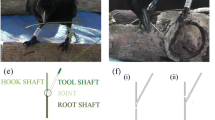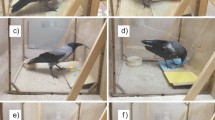Abstract
Contrasting findings made it unclear what cognitive processes New Caledonian crows use to procure suitable tools to solve tool tasks. Most previous studies suggested that their tool procurement is achieved by either trial and error or a simple heuristic. The latter provides a fast and cognitively efficient method for stable, routinized behaviour based on past experience with little or no deliberate decision-making. However, early papers by Chappell and Kacelnik reported that two New Caledonian crows procured tools after closely assessing the tool characteristics required for the task, thus using deliberate decision-making, or a ‘customized strategy’. Here, I tested eight New Caledonian crows to determine their default behaviour in basic tool procurement tasks as a check on whether or not they use customized strategies. I used two rigorous experiments closely based on Chappell and Kacelnik’s experiments. The crows did not use a customized strategy in either experiment, but their behaviour was clearly consistent with tool procurement predominantly guided by a familiarity heuristic. I discuss potential methodological issues that may have led to different conclusions in Chappell and Kacelnik’s studies. Heuristic-guided, routinized behaviour in tool procurement has potential implications for understanding how standardization occurs in the early evolution of complex tool manufacture, both in New Caledonian crows and early humans.





available at each position. a Experiment 1. b Experiment 2. Mean length/diameter of tools provided at each position in the tool rack (black bars) compared with the mean of the first tools used that crows selected from each position (grey bars, sample sizes above error bars for standard deviation)




Similar content being viewed by others
References
Albarracin D, Wyer RS Jr (2000) The cognitive impact of past behavior: influences on beliefs, attitudes, and future behavioral decisions. J Pers Soc Psychol 79:5–22
Auersperg AMI, Kőck C, O’Hara M, Huber L (2018) Tool making cockatoos adjust the lengths but not the widths of their tools to function. PLoS ONE 13:e0205429
Barr DJ, Levy R, Scheepers C, Tily HJ (2013) Random effects structure for confirmatory hypothesis testing: keep it maximal. J Mem Lang 68:255–278
Bates D, Mächler M, Bolker B, Walker S (2015) Fitting linear mixed-effects models using lme4. J Stat Softw 67:1–48
Bird CD, Emery NJ (2009) Insightful problem solving and creative tool modification by captive nontool-using rooks. Proc Nat Acad Sci USA 106:10370–10375
Bluff LA, Troscianko J, Weir AAS, Kacelnik A, Rutz C (2010) Tool use by wild New Caledonian crows Corvus moneduloides at natural foraging sites. Proc R Soc B Biol Sci 277:1377–1385
Bluff LA, Weir AAS, Rutz C, Wimpenny JH, Kacelnik A (2007) Tool-related cognition in New Caledonian crows. Comp Cogn Behav Rev 2:1–25
Chappell J, Kacelnik A (2002) Tool selectivity in a non-mammal, the New Caledonian crow (Corvus moneduloides). Anim Cogn 5:71–78
Chappell J, Kacelnik A (2004) Selection of tool diameter by New Caledonian crows Corvus moneduloides. Anim Cogn 7:121–127
Charbonneau M (2018) Technical constraints on the convergent evolution of technologies. In: O’Brien MJ, Buchanan B, Eren MI (eds) Convergent evolution in stone-tool technology. MIT Press, Cambridge MA, pp 73–89
Cooper R (2000) Simple heuristics could make us smart; but which heuristics do we apply when? Behav Brain Sci 23:746
Fox J, Weisberg S (2011) An R companion to applied regression, 2nd edn. Sage Publications, Thousand Oaks
Gigerenzer G, Todd PM, The ABC Research Group (1999a) Simple heuristics that make us smart. Oxford University Press, Oxford
Gigerenzer G, Czerlinski J, Martignon L (1999b) How good are fast and frugal heuristics? In: Shanteau J, Mellers BA, Schum DA (eds) Decision Science and Technology. Springer, Boston, pp 81–103
Gross J, Zank C, Hobbs N, Spalinger DE (1995) Movement rules for herbivores in spatially heterogeneous environments: responses to small scale pattern. Landsc Ecol 10:209–217
Holzhaider JC, Sibley MD, Taylor AH, Singh PJ, Gray RD, Hunt GR (2011) The social structure of New Caledonian crows. Anim Behav 81:83–92
Huber O (2000) What’s in the adaptive toolbox: global heuristics or more elementary components? Behav Brain Sci 23:755
Hutchinson JMC, Gigerenzer G (2005) Simple heuristics and rules of thumb: Where psychologists and behavioural biologists might meet. Behav Process 69:97–124
Hunt GR (2016) Social and spatial reintegration success of New Caledonian crows released after aviary confinement. Wilson J Ornithol 128:168–173
Hunt GR (2000a) Tool use by the New Caledonian crow Corvus moneduloides to obtain Cerambycidae from dead wood. Emu 100:109–114
Hunt GR (2000b) Human-like, population-level specialization in the manufacture of pandanus-tools by New Caledonian crows Corvus moneduloides. Proc R Soc Lond B Biol Sci 267:403–413
Hunt GR (1996) Manufacture and use of hook-tools by New Caledonian crows. Nature 379:249–251
Hunt GR, Gray RD (2004) The crafting of hook tools by wild New Caledonian crows. Proc R Soc Lond B Biol Sci (Suppl) 271:S88–S90
Hunt GR, Gray RD (2003) Diversification and cumulative evolution in New Caledonian crow tool manufacture. Proc R Soc Lond B Biol Sci 270:867–874
Hunt GR, Gray RD (2002) Species-wide manufacture of stick-type tools by New Caledonian crows. Emu 102:349–353
Hunt GR, Rutledge RB, Gray RD (2006) The right tool for the job: What strategy do wild New Caledonian crows use? Anim Cogn 9:307–316
Jelbert SA, Miller R, Schiestl M, Boeckle M, Cheke LG, Gray RD, Taylor AH, Clayton NS (2019) New Caledonian crows infer the weight of objects from observing their movements in a breeze. Proc R Soc B Biol Sci 286:20182332
Jelbert SA, Taylor AH, Cheke LG, Clayton NS, Gray RD (2014) Using the Aesop’s Fable paradigm to investigate causal understanding of water displacement by New Caledonian crows. PLoS ONE 9:e92895
Kenward B, Rutz C, Weir AAS, Chappell J, Kacelnik A (2004) Morphology and sexual dimorphism of the New Caledonian crow Corvus moneduloides, with notes on its behaviour and ecology. Ibis 146:652–660
Knaebe B, Taylor AH, Elliffe DM, Gray RD (2017) New Caledonian crows show behavioural flexibility when manufacturing their tools. Behaviour 154:65–91
Komsta L, Novomestky F (2015) Package ‘moments’. R package version 0.14. https://CRAN.R-project.org/package=moments. Accessed June 2020
Ludwig A, Bigras-Poulin M, Lair S, Belanger D (2009) Morphological description of American crow, Corvus brachyrhynchos, populations in southern Québec. Can Field Nat 123:33–140
Lycett SJ, Schillinger K, Eren MI, von Cramon-Taubadel N, Mesoudi A (2016) Factors affecting Acheulean handaxe variation: experimental insights, microevolutionary processes, and macroevolutionary outcomes. Quatern Int 411:386–481
Matsui H, Hunt GR, Oberhofer K, Ogihara N, McGowan KJ, Mithraratne K, Yamasaki T, Gray RD, Izawa E (2016) Adaptive bill morphology for enhanced tool manipulation in New Caledonian crows. Sci Rep 6:22776
Miller R, Jelbert SA, Taylor AH, Cheke LG, Gray RD, Loissel E, Clayton NS (2016) Performance in object-choice Aesop's Fable tasks are influenced by object biases in New Caledonian crows but not in human children. PLoS ONE 11:e0168056
Ouellette JA, Wood W (1998) Habit and intention in everyday life: the multiple processes by which past behavior predicts future behavior. Psychol Bull 124:54–74
Pinheiro J, Bates D, DebRoy S, Sarkar D, R Development Core Team (2013) Nlme: Linear and nonlinear mixed effects models. R package version 3.1–108 https://CRAN.R-project.org/package=nlme. Accessed June 2020
Pohlert T (2014) The pairwise multiple comparison of mean ranks package (PMCMR). R package, https://CRAN.R-project.org/package=PMCMR. Accessed June 2020
Pyke GH (1981) Optimal foraging in hummingbirds: rules of movement between inflorescences. Anim Behav 29:889–896
R Core Team (2020) R: A language and environment for statistical computing. Vienna, R Foundation for Statistical Computing. https://www.R-project.org/. Accessed June 2020
Reynolds AM, Lihoreau M, Chittka L (2013) A simple iterative model accurately captures complex trapline formation by bumblebees across spatial scales and flower arrangements. PloS Comput Biol 9:e1002938
Rutz C, Bluff LA, Weir AAS, Kacelnik A (2007) Video cameras on wild birds. Science 318:765
Santos LR, Rosati AG (2015) The evolutionary roots of human decision making. Annu Rev Psychol 66:321–347
Silva FJ, Silva KM (2010) How do humans compare with New Caledonian crows in tool selectivity? Learn Behav 38:87–95
Silva FJ, Silva KM (2012) More but not less uncertainty makes adult humans’ tool selections more similar to those reported with crows. Learn Behav 40:494–506
Schillinger K, Mesoudi A, Lycett SJ (2015) The impact of imitative versus emulative learning mechanisms on artifactual variation: implications for the evolution of material culture. Evol Hum Behav 36:446–455
Stevens JR, King AJ (2012) The lives of others: social rationality in animals. The ABC Research Group. In: Hertwig R, Hoffrage U (eds) Simple heuristics in a social world. Oxford, Oxford University Press, pp 409–431
Taylor AH, Elliffe DM, Hunt GR, Emery NJ, Clayton NS, Gray RD (2011) New Caledonian crows learn the functional properties of novel tool types. PLoS ONE 6:e26887
Tebbich S, Bshary R (2004) Cognitive abilities related to tool use in the woodpecker finch, Cactospiza pallida. Anim Behav 67:689–697
Teichroeb JA, Smeltzer EA (2018) Vervet monkey (Chlorocebus pygerythrus) behavior in a multi-destination route: Evidence for planning ahead when heuristics fail. PLoS ONE 13:e0198076
Todd PM, Gigerenzer G (2000) Précis of Simple heuristics that make us smart. Behav Brain Sci 23:727–780
Troscianko J, von Bayern AMP, Chappell J, Rutz C, Martin GR (2012) Extreme binocular vision and a straight bill facilitate tool use in New Caledonian crows. Nature Comm 3:1110
Tyrrell LP, Fernández-Juricic E (2017) Avian binocular vision: it's not just about what birds can see, it's also about what they can't. PLoS ONE 12:e0173235
Weir AAS, Kacelnik A (2006) A New Caledonian crow (Corvus moneduloides) creatively re-designs tools by bending or unbending aluminium strips. Anim Cogn 9:317–334
Weir AAS, Chappell J, Kacelnik A (2002) Shaping of hooks in New Caledonian crows. Science 297:981
Wimpenny JH, Weir AAS, Clayton L, Rutz C, Kacelnik A (2009) Cognitive processes associated with sequential tool use in New Caledonian crows. PLoS ONE 4:e6471
Acknowledgements
I thank the Province Sud authorities for allowing me to carry out research on New Caledonian crows. Dean and Beatrice Simitch kindly allowed us to capture New Caledonian crows on their Moindou property. Kevin Chang and Jessica McLay of the Auckland University Statistics Department provided assistance with the LMM analyses, and Jessica McLay provided the calculations and R code for Figure S1. Christian Rutz provided helpful comments on a late draft of the manuscript. I thank the Associate Editor and the two reviewers for their helpful suggestions which improved the manuscript.
Funding
My field work was funded by New Zealand Royal Society Marsden Grant UOA1208. Data analysis and manuscript preparation were self-funded.
Author information
Authors and Affiliations
Corresponding author
Ethics declarations
Conflict of interest
The author declares that he has no conflict of interest.
Additional information
Publisher's Note
Springer Nature remains neutral with regard to jurisdictional claims in published maps and institutional affiliations.
Electronic supplementary material
Below is the link to the electronic supplementary material.
Supplementary file1 (MP4 5820 kb)
Supplementary file2 (MP4 4651 kb)
Supplementary file3 (MP4 6081 kb)
Rights and permissions
About this article
Cite this article
Hunt, G.R. New Caledonian crows' basic tool procurement is guided by heuristics, not matching or tracking probe site characteristics. Anim Cogn 24, 177–191 (2021). https://doi.org/10.1007/s10071-020-01427-7
Received:
Revised:
Accepted:
Published:
Issue Date:
DOI: https://doi.org/10.1007/s10071-020-01427-7




